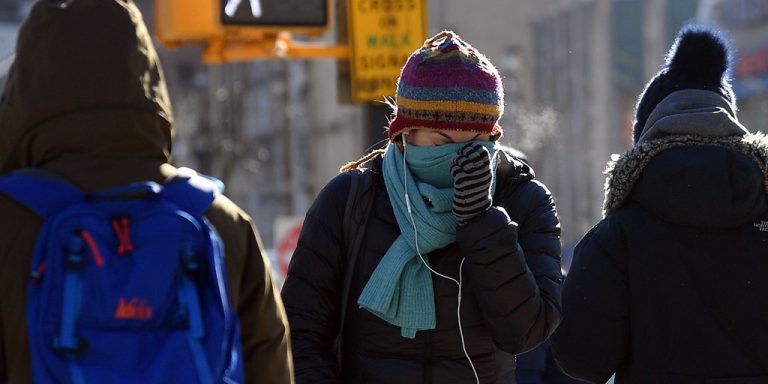Chill out: An Arctic blast froze much of the United States late in the week
The coldest air of the season will ship into the United States from the Arctic this weekend. Low temperatures in the northern tier will be 10 to 20 degrees below zero, while cities like Kansas City will struggle to make it above zero at highs.
Dusting off the jackets. After a mild December, the polar vortex is set to send a polar blast to the United States later this week.
“That arctic plane is going to be pushed south, and guess what that's going to do. It's opening the freeze,” said FOX Weather meteorologist Kendall Smith. “So all of this cold polar air that was trapped over Canada, right over the North Pole, is going to make its way straight into the lower 48.”
According to the FOX Forecast Center, this will likely be the coldest air felt across the Lower 48 so far this winter. The cold begins late in the week in the Intermountain West and then extends into the central United States early next week. The cold air will stick around for a while.
When is the coldest time of the year?
FILE: Ice covers the shore of Lake Michigan on Jan. 30, 2019 in Chicago as the polar vortex extended south. (Scott Olson/Getty Images)
How cold will it get?
Temperatures may drop by the end of the week to between 30-50 degrees below normal for this time of year in some locations. Wind chills could approach -50 degrees in several places.
7 ways to protect your pet in winter
Temperature forecasts from the Climate Prediction Center show well below average temperatures in Minneapolis, Kansas City, Little Rock, Arkansas, Nashville, Tennessee, and Chicago through January 18.
Here's how long it will take until you get frostbite as wind chills drop below zero
Temperature forecasts show well below average temperatures through January 18. (Fox Weather)
What is hypothermia?
Why were winters mild, and what changes that?
El Niño is partly responsible for the mild winter so far in the United States. During an El Niño winter, temperatures in the northern United States are usually warmer and drier than average, according to the National Oceanic and Atmospheric Administration (NOAA). The jet stream generally flows from west to east.
“We were pretty lucky for a good part of December and into the beginning of January, but now it's kind of a page-turner, if you will, a complete flip of the script,” Smith said. “Because now we're starting to see that cold air being held in place over Canada and over the Arctic. And that's going to start to change.”
Can cold weather make you sick?
FILE: A man clenches his fists as he walks past a steam vent on the morning of January 7, 2014 in New York, United States. A polar vortex has descended on much of North America, coming from the North Pole, bringing record freezing temperatures to much of the country. (Andrew Burton/Getty Images)
7 points for cold weather safety
About two weeks ago, the North Pole experienced a sudden, slight stratospheric rise. Amy Butler of the National Oceanic and Atmospheric Administration's (NOAA) Chemical Sciences Laboratory wrote that the air in the stratosphere, a layer of Earth's atmosphere, about 19 miles above the surface, warmed by 55 degrees in a six-day period. This slowed the winds of the polar vortex.
About every two years, weather events in the lower atmosphere send powerful atmospheric waves into the stratosphere, which interact with the polar vortex.
The polar vortex is a band of strong winds swirling around the North Pole. The constant and stable circulation of these winds keeps the Arctic air fixed in place. When the wind slows and becomes unstable, just like a crest, the vortex oscillates. Stratospheric weather is ahead of our own by up to two weeks, according to Judah Cohen, an atmospheric scientist from Verisk Atmospheric and Environmental.
How to watch Fox Weather
The polar vortex on the left is from January 1 and on the right is the forecast for January 14 showing cold air extending south. (NOAA Climate.gov)
How to dress warmly for winter weather adventures
“Polar vortex disruption is called sudden stratospheric warming, where there is a significant temperature rise in the Arctic in the stratosphere, and then the polar vortex migrates southward, away from its usual place in the Arctic, to the south,” Cohen said. “So the cold air is able to move southward, and then, at the surface, that often manifests as a negative Arctic Oscillation.”
During the Great Texas Freeze of February 2021, the Arctic Oscillation was at its lowest and most negative levels in eight years. The northern population is also associated with a negative Arctic Oscillation phase, according to the National Oceanic and Atmospheric Administration (NOAA).
On this day: The Great Texas Freeze has begun and will rank among the worst winter storms in history
Looking back at the Great Texas Freeze one year later
FOX Weather multimedia journalist Robert Ray is in Houston, Texas, as we reflect on the Great Texas Freeze one year later.
Cold Weather Safety: How to stay safe if you're affected by a crippling power outage
How long will the dangerous cold last?
It is still unclear how long the cold air will remain in place over the past week.
“However, there remains significant uncertainty about how the polar vortex will develop after mid-January,” Butler wrote. “Meanwhile, there are signs that even this slight warming may help boost the chances of cold weather patterns in some areas over the next two weeks – stay tuned!”

